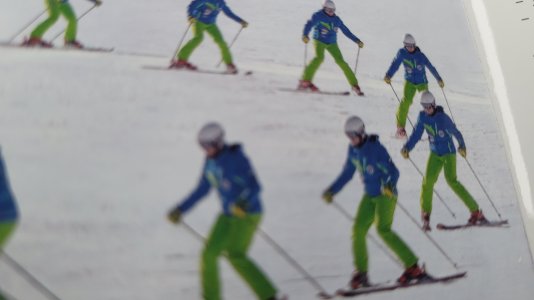Ach, OK.
Oto problem japońskiej wersji demonstracyjnej – jest ona na zbyt stromym terenie. Tylko dlatego, że mają taki obszar demonstracyjny. Kiedy teren jest tak stromy, klin staje się bardzo szeroki. Powyższe niebiesko-żółte zdjęcie narciarzy jest również zbyt szerokie. Japońskiemu zespołowi demonstracyjnemu ujdzie to na sucho, ponieważ jest bardzo wykwalifikowany i wyćwiczony. Nie jest łatwo sprawić, by wyglądał tak dobrze na stromym terenie. Jestem pewien, że nie lubią tego robić w tym terenie, bo to boli.
Jak mówi JF Beaulieu w filmie o wahadle zamieszczonym w innym wątku, gdy klin jest tak szeroki, jedyną opcją jest
pchanie narty zewnętrznej. Zamiast po prostu na niej balansować, gdy wewnętrzna narta spłaszcza się w wyniku
lekkiego ruchu do wewnątrz i/lub przechylania wewnętrznej stopy i kolana w kierunku małego palca.
Szeroki klin jest dla dorosłych trudny i niewygodny do noszenia przez bardzo długi czas. Jednak ze względów bezpieczeństwa zazwyczaj lepiej jest się trzymać. Gdy już wkręcimy się w bardzo szeroki klin, ciężko będzie z niego zrezygnować.
Zauważ jednak, że Japończycy poruszają się do środka w kierunku środka zakrętu, balansując na zewnątrz. Jeśli ukryjesz ich dolne części nóg i narty, będzie to wyglądać bardzo podobnie do ich równoległych zakrętów.
Niebieski/żółty nie za bardzo. Wygląda na to, że wychodzi na zewnętrzną nartę. Tak jak nauczono twoją żonę. Dla mnie jest to ruch negatywny i coś w rodzaju ślepego zaułka. Nie inicjujemy równoległych zwrotów przesuwając ciało w lewo, aby skręcić w prawo.
W USA nie byłoby to równoznaczne z zwrotem akcji na egzaminie.
Podejrzewam jednak, że jest to nadal powszechne w niektórych częściach kraju. Kiedyś wisiał plakat o epickich nartach z Finlandii, na którym zamieszczano wszystkie informacje na temat nauczania tego. Teraz w całym Internecie można znaleźć filmy z carvingiem i kilka naprawdę fajnych filmów przedstawiających zawodników Wcup jeżdżących na nartach poza trasą. Nie sądzę, żeby nadal opowiadał się za odchylaniem się na niskich poziomach, ale nie wiem. Triggerboy62 to nazwa użytkownika YouTube, dawniej tdk6 na epicski.
Używaj łagodnego terenu, wąskiego klina
ślizgowego . Szeroki klin nazywany jest klinem hamującym. Unikaj jak najwięcej. Kontroluj prędkość według linii, którą podążasz, kieruj się pod górę, aby zwolnić. Jeśli to możliwe, zatrzymaj się, skręcając pod górę, J.
Zakręty powinny być pozytywnymi zdarzeniami ślizgowymi, a nie defensywnymi hamowaniami. Najlepszym sposobem na zapewnienie tego jest bardzo łagodny teren.
A nie jakaś wersja tego:
Instrukcja jazdy na nartach armii amerykańskiej w 1941 r . -
View attachment 218393
Zakręt pługu śnieżnego. Ruch skręcający w prawo to ruch w lewo.
Ale
oto sprzęt -
View attachment 218395
View attachment 218394
Bardzo długie narty, bardzo niskie skórzane buty, pięta nie trzyma się mocno.
